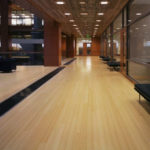 While we all love bamboo gardens and oftentimes see bamboo stalks as decoration in more modern or Asian inspired homes; have you ever actually given thought to having it underfoot in your own house? Because of its exotic and unique appearance among many other factors, an increasingly popular trend in the design industry is just that – building and refurbishing home spaces with bamboo floors.
While we all love bamboo gardens and oftentimes see bamboo stalks as decoration in more modern or Asian inspired homes; have you ever actually given thought to having it underfoot in your own house? Because of its exotic and unique appearance among many other factors, an increasingly popular trend in the design industry is just that – building and refurbishing home spaces with bamboo floors.
Often thought of as a wood, bamboo is actually a grass and when glued together, forms solid engineered planks similar to other hard wood options on the market today but details a more modern and chic look. It is a distinctive flooring option (especially in our Montana neck of the woods) that comes in a variety of grain patterns and color choices that can appeal to many personal tastes. Read on for the pros and cons of bamboo flooring to see if it is right for your own lifestyle.
Affordable – One of the biggest benefits of bamboo flooring is that when compared to other wood flooring options, it can be much more affordable ranging from just $2 to $5 per square foot whereas most hard wood options range from $5 to $15 per square foot depending on the wood material and how hard it is. Thus, if doing a large space, choosing bamboo can oftentimes fit better within a budget.
Durable – Similar to hard wood, bamboo is praised for its durability. When maintained properly, bamboo flooring can be expected to last as long as or longer than traditional hard wood flooring options. It is easy to be maintained and is relatively water and stain resistant and depending on the type, can be also resistant to warping.
Environmentally Friendly – Unlike a number of wood flooring options, bamboo is one of the most sustainable and environmentally friendly selections on the market. As bamboo is a grass, it grows and matures in just a few years whereas wood counterparts require decades to mature before being usable. Bamboo can be harvested without replanting as well when cut down as the root system is left in place and reproduces on its own at a far more rapid pace than wood. The material also grows in a natural environment needing no irrigation or pesticides or the use of chemicals to maintain its quality and ensure its healthiness while growing.
While bamboo flooring does comes with many benefits, the main disadvantage is that it is not American made and has to be imported in from China and other parts of Asia. One of the biggest debates regarding its eco-friendly footprint is this inconvenience and the energy it takes to transport bamboo around the world. Another con is that while it may be easy to be maintained and is more resistant to warping and water damage than wood; it is not exempt from scratches and over many years, will need to be refinished to again look like new.
Photos courtesy of Classic Floor Designs